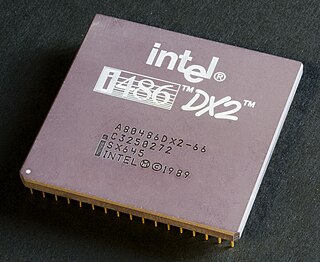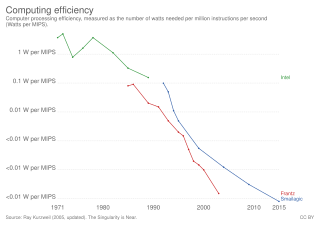Related Research Articles

A central processing unit (CPU), also called a central processor, main processor or just processor, is the electronic circuitry that executes instructions comprising a computer program. The CPU performs basic arithmetic, logic, controlling, and input/output (I/O) operations specified by the instructions in the program. This contrasts with external components such as main memory and I/O circuitry, and specialized processors such as graphics processing units (GPUs).
Processor design is a subfield of computer engineering and electronics engineering (fabrication) that deals with creating a processor, a key component of computer hardware.
Dhrystone is a synthetic computing benchmark program developed in 1984 by Reinhold P. Weicker intended to be representative of system (integer) programming. The Dhrystone grew to become representative of general processor (CPU) performance. The name "Dhrystone" is a pun on a different benchmark algorithm called Whetstone, which emphasizes floating point performance.

Alpha is a 64-bit reduced instruction set computer (RISC) instruction set architecture (ISA) developed by Digital Equipment Corporation (DEC). Alpha was designed to replace 32-bit VAX complex instruction set computers (CISC) and to be a highly competitive RISC processor for Unix workstations and similar markets.

Fortran is a general-purpose, compiled imperative programming language that is especially suited to numeric computation and scientific computing.

Instructions per second (IPS) is a measure of a computer's processor speed. For complex instruction set computers (CISCs), different instructions take different amounts of time, so the value measured depends on the instruction mix; even for comparing processors in the same family the IPS measurement can be problematic. Many reported IPS values have represented "peak" execution rates on artificial instruction sequences with few branches and no cache contention, whereas realistic workloads typically lead to significantly lower IPS values. Memory hierarchy also greatly affects processor performance, an issue barely considered in IPS calculations. Because of these problems, synthetic benchmarks such as Dhrystone are now generally used to estimate computer performance in commonly used applications, and raw IPS has fallen into disuse.

In computing, overclocking is the practice of increasing the clock rate of a computer to exceed that certified by the manufacturer. Commonly, operating voltage is also increased to maintain a component's operational stability at accelerated speeds. Semiconductor devices operated at higher frequencies and voltages increase power consumption and heat. An overclocked device may be unreliable or fail completely if the additional heat load is not removed or power delivery components cannot meet increased power demands. Many device warranties state that overclocking or over-specification voids any warranty, however there are an increasing number of manufacturers that will allow overclocking as long as performed (relatively) safely.

The Standard Performance Evaluation Corporation (SPEC) is an American non-profit corporation that aims to "produce, establish, maintain and endorse a standardized set" of performance benchmarks for computers.

OpenMP is an application programming interface (API) that supports multi-platform shared-memory multiprocessing programming in C, C++, and Fortran, on many platforms, instruction-set architectures and operating systems, including Solaris, AIX, FreeBSD, HP-UX, Linux, macOS, and Windows. It consists of a set of compiler directives, library routines, and environment variables that influence run-time behavior.

Crafty is a chess program written by UAB professor Dr. Robert Hyatt, with continual development and assistance from Michael Byrne, Tracy Riegle, and Peter Skinner. It is directly derived from Cray Blitz, winner of the 1983 and 1986 World Computer Chess Championships. Tord Romstad, the author of Stockfish, described Crafty as "arguably the most important and influential chess program ever".

In computing, a benchmark is the act of running a computer program, a set of programs, or other operations, in order to assess the relative performance of an object, normally by running a number of standard tests and trials against it.
SPECint is a computer benchmark specification for CPU integer processing power. It is maintained by the Standard Performance Evaluation Corporation (SPEC). SPECint is the integer performance testing component of the SPEC test suite. The first SPEC test suite, CPU92, was announced in 1992. It was followed by CPU95, CPU2000, and CPU2006. The latest standard is SPEC CPU 2017 and consists of SPECspeed and SPECrate.

Sun Microsystems' UltraSPARC T2 microprocessor is a multithreading, multi-core CPU. It is a member of the SPARC family, and the successor to the UltraSPARC T1. The chip is sometimes referred to by its codename, Niagara 2. Sun started selling servers with the T2 processor in October 2007.

The Sun Microsystems Ultra 80 is a computer workstation that shipped from November 1999 to 2002.

The VIA Nano is a 64-bit CPU for personal computers. The VIA Nano was released by VIA Technologies in 2008 after five years of development by its CPU division, Centaur Technology. This new Isaiah 64-bit architecture was designed from scratch, unveiled on 24 January 2008, and launched on 29 May, including low-voltage variants and the Nano brand name. The processor supports a number of VIA-specific x86 extensions designed to boost efficiency in low-power appliances.
XL C/C++ is the name of IBM's proprietary optimizing C/C++ compiler for IBM-supported environments.
NBench, short for Native mode Benchmark and later known as BYTEmark, is a synthetic computing benchmark program developed in the mid-1990s by the now defunct BYTE magazine intended to measure a computer's CPU, FPU, and Memory System speed.
The x32 ABI is an application binary interface (ABI) and one of the interfaces of the Linux kernel. It allows programs to take advantage of the benefits of x86-64 instruction set while using 32-bit pointers and thus avoiding the overhead of 64-bit pointers.
The LINPACK Benchmarks are a measure of a system's floating-point computing power. Introduced by Jack Dongarra, they measure how fast a computer solves a dense n by n system of linear equations Ax = b, which is a common task in engineering.
References
- 1 2 "The SPEC Benchmarks". 2003-02-03. Retrieved 2010-07-24.
- ↑ "SPEC CPU2017 Documentation". 2018-05-18. Retrieved 2018-10-24.
- ↑ "SPEC CPU2006". 2010-06-16. Retrieved 2010-07-25.
- 1 2 "SPEC CPU2000". 2007-06-07. Retrieved 2010-07-25.
- ↑ "CFP2006 (Floating Point Component of SPEC CPU2006)". 2006-09-27. Retrieved 2010-07-25.
- 1 2 "SPEC CPU95 Benchmarks". 2003-09-23. Retrieved 2010-07-25.
- ↑ "CFP2000 (Floating Point Component of SPEC CPU2000)". 2003-10-16. Retrieved 2010-07-25.
- ↑ "SPEC CFP95 Benchmarks". 2003-09-26. Retrieved 2010-07-25.
- ↑ "SPEC CPU92 Benchmarks". 2003-09-23. Retrieved 2010-07-25.
- ↑ "baseline.txt". 2003-09-26. Retrieved 2010-07-25.
- ↑ "CFP92 Benchmarks". 2003-09-26. Retrieved 2010-07-25.